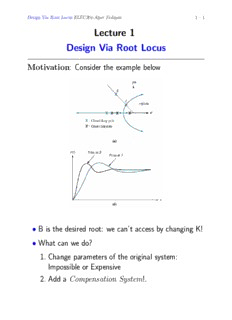
Design Via Root Locus ELEC304-Alper Erdogan 1 - Koç Hastanesi PDF
Preview Design Via Root Locus ELEC304-Alper Erdogan 1 - Koç Hastanesi
Design Via Root Locus ELEC304-Alper Erdogan 1 – 1 Lecture 1 Design Via Root Locus Motivation: Consider the example below • B is the desired root: we can’t access by changing K! • What can we do? 1. Change parameters of the original system: Impossible or Expensive 2. Add a Compensation System!. Design Via Root Locus ELEC304-Alper Erdogan 1 – 2 A Compensation System? Simple controller system with two purposes: • Improving the transient response by changing pole locations. (Differentiator Based) • Improving the steady-state performance. (Integrator Based) There are 2 types of compensators (Depending on where you place the compensator system): Cascade(a) or Feedback(b) Design Via Root Locus ELEC304-Alper Erdogan 1 – 3 Improving Steady State Performance Goal: Improve steady state performance without affecting transient response. Basic Strategy: Add integrators to increase the type of the system Two Common Techniques: 1 • Ideal Integrator (a pole on origin): G (s) = K(a + ). 1 s – Increases the system type, can make steady-state error zero. (Excellent!) – Requires use of active elements(i.e., elements requiring power supply)(Expensive!) • Non-ideal Integrator with a pole near origin. s−z G (s) = c 1 s−p c – Can not the increase system type, but can significantly improve steady state error performance. (Nice!) – Requires passive elements only, so it is cheap. (Very Nice!) Note that both approaches have a zero in addition to the pole. We will see why very soon... Design Via Root Locus ELEC304-Alper Erdogan 1 – 4 Compensator Naming Convention (for ideal compensators) • Proportional Controller: feed scaled error to the plant. G (s) = K. (1) 1 • Integral Controller: feed integrated error to the plant. K G (s) = (2) 1 s . • Derivative Controller: feed differentiated error to the plant. G (s) = Ks. (3) 1 • Proportional-plus-Integrator (PI): feed scaled+integrated error to the plant: 1 G (s) = K(a + ). (4) 1 s Design Via Root Locus ELEC304-Alper Erdogan 1 – 5 Ideal Integral (PI) Compensator Consider the following Example • (a) No Compensation • (b) Only Integrator: – Steady-state performance improved. – However, the transient response in (a) can not be achieved! Design Via Root Locus ELEC304-Alper Erdogan 1 – 6 Ideal Integral (PI) Compensator: Continued Now consider the following compensation: • (c) Proportional+Integrator: – Transient Response almost unaffected!. – Steady State Improved. 1 K So the choice of G (s) = K(a + ) over should be 1 s s clear now!: the inclusion of the proportional part ( and therefore the zero) avoids the effect on the transient response Design Via Root Locus ELEC304-Alper Erdogan 1 – 7 Ideal Integral (PI) Compensator: Example Consider the following example: The Root-Locus for Uncompensated System K=164.6 provides: • Damping Ratio: ζ = 0.174. 1 • Steady State Error: e(∞) = = 0.108. 1+Kp Design Via Root Locus ELEC304-Alper Erdogan 1 – 8 Ideal Integral (PI) Compensator: Example Continued Now with an ideal integrator ( PI) controller Root Locus is very similar: For this case • Damping Ratio unchanged (with K = 158.2). • Steady State Error is ZERO!. Design Via Root Locus ELEC304-Alper Erdogan 1 – 9 How to Implement PI Controller? K K (s + 2) 2 K G (s) = K + = K 1 (1) c 1 1 s s Simple!, use the following: • Made steady-state error zero!. • However, it is expensive to implement as the integrator requires active elements. • We may want to use the solution presented next: Lag Compensation. Design Via Root Locus ELEC304-Alper Erdogan 1 – 10 Lag Compensation: A Cheaper Solution Similar to the Ideal Integrator, however it has a pole not on origin but close to the origin. s + z c G (s) = (1) 1 s + p c
Description: